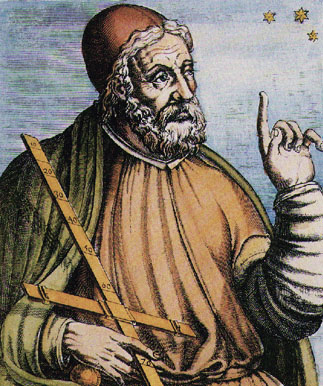| Ptolemy  AKA Claudius Ptolemaeus AKA Claudius Ptolemaeus
Born: c. 87 AD
Birthplace: Alexandria, Egypt
Died: c. 150 AD
Location of death: Alexandria, Egypt
Cause of death: unspecified
Gender: Male
Race or Ethnicity: White
Occupation: Astronomer, Cartographer, Mathematician Nationality: Ancient Rome
Executive summary: Egyptian geographer and astronomer Ptolemy, a celebrated astronomer and geographer, whose proper name is Claudius Ptolemaeus, was a native of Egypt, though it is uncertain whether he was born at Pelusium or Ptolemais in the Thebaid. Nothing is known of his personal history, except that he flourished in Alexandria in 139 AD, and there is probable evidence of his having been alive in 161 AD. The chief of his writings are: Megale Syntaxis tes Astronomias, which, to distinguish it from the next-mentioned, was probably denominated by the Arabs megiste, the greatest, from which is derived the name Almagest, by which it is generally known; Tetrabiblos Syntaxis, with which is combined another work, called Karpos or Centiloquium, from it containing a hundred aphorisms, both works treating of astrological subjects and held by some on this account to be of doubtful genuineness; Phaeis aplanon asteron kai synagoge episemaseion, a treatise on the phenomena of the fixed stars, or a species of almanac; Geographike Hyphegesis, his great geographical work, in eight books. The rest of his works are of inferior importance, and consist of descriptions of various kind of Projections, the thory of the musical scale, chronological and metaphysical treatises, and a summary of the hypotheses employed in his great work, the Almagest. Others of Ptolemy's works have been lost, and it is still a moot point whether or not they contained a treatise on optics, as a Latin version of what is said to have been an Arabic translation of Ptolemy's original treatise on that subject is still in existence.
Both as an astronomer and geographer, Ptolemy held supreme sway over the minds of almost all the scientific men from his own time own until about the 15th century; but, and in astronomy specially, he seems to have been not so much an independent investigator as a corrector and improver of the works of his predecessors. In astronomy, he had the labors of Hipparchus to guide him; and, indeed, scrupulously distinguishes between Hipparchus's labors and his own. To Ptolemy belongs the invention of a planetary theory, the discovery of the moon's evection, and the singular distinction of being the sole existing authority on the subject of ancient astronomy. From this last-mentioned fact, the system of astronomy which he sets forth in the Almagest received his name; and, as the Ptolemaic System, obtained the homage of succeeding generations until the time of Nicolaus Copernicus. The Almagest is divided into thirteen books. Ptolemy seems to have been little of an independent observer, trusting implicitly to his predecessor, Hipparchus; but his geometical powers were of a very high order, unless, as Delambre suggests (most likely incorrectly), the leegant demonstrations here and there occurring in the Almagest were borrowed from other sources.
As a geographer Ptolemy occupies a similar position to what he holds in astronomy; he appears before his readers as the corrector and improver of the works of a predecessor, Marinus of Tyre, about whom, except from Ptolemy's writings, little is known. Ptolemy here seems to more advantage as an independent investigator, and his improvements and suggestions are at once more valuable and correct; but it is sometimes difficult to separate his data from those of Marinus. His geography is divided into eight books, all of which, with exception of the first, eight, and a portion of the seventh, are nothing more than a gazeteer, to 12ths of a degree, with a brief general description prefixed to each continent and country or tribe, and interspersed here and there with remarks of a miscellaneous character on any point of interest. The rest of the work contains details regarding his mode of nothing the positions of places -- by latitude (mekos) and longitude (platos) -- with the calculation of the size of the sphere of the arth, and the extent of surface then known. He also describes the mode adopted by him of projecting the surface of a hemisphere on a flat surface, and shows its superiority over the projections of Eratosthenes, Hipparchus, and Marinus. He also constructed a series of twenty-six maps, together with a general map of the world, in illustration of his work.
The Almagest and Geography were the first standard textbooks to succeeding ages, the first until the time of Copernicus, the second until the great maritime discoveries of the 15th century demonstrated its deficiencies. They have passed through numerous editions, the best of which are, for the Almagest and most of his minor works, that of Halma (Paris, 1813-16, etc.); and for the Geography, the Latin versions of 1482 and 1490, published at Rome, the editio princeps of the Greek text by Erasmus (Lugd. Bat. 1619). The catalogue of stars has been frequently printed separately.
Lunar Crater Ptolemaeus (9.3S, 1.9W, 164km dia)
Do you know something we don't?
Submit a correction or make a comment about this profile
Copyright ©2019 Soylent Communications
|